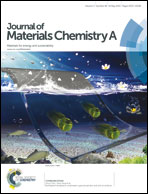Thermite-driven melamine condensation to CxNyHz graphitic ternary polymers: towards an instant, large-scale synthesis of g-C3N4†
Abstract
Utilization of heat released from the classical aluminothermic reaction (Fe2O3 + Al) for thermal condensation of melamine allows production of a large amount of C/N/H graphitic ternary polymers within a matter of a few minutes. This approach could allow instant, large-scale synthesis of g-C3N4. A detailed, comparative study of melamine condensation to hydrogen-rich melon-related CxNyHz graphitic ternary polymers (which can be considered as a pre-stage to carbon(IV) nitride) initiated by resistance furnace or by thermite reaction is presented. The products obtained by both heating routes at two different temperatures (560 and 640 °C) are compared and analyzed. It is shown that the photocatalytic activity of the CxNyHz polymers correlates with the hydrogen content in the materials. The superiority of the thermite-heated process over electric resistance furnace heating is elucidated. The exceptional characteristics of the thermite reaction, that is the use of cheap, ubiquitous substrates, rapid increase of temperature and peerless exothermicity, make it suitable for efficient, large-scale transformation of a variety of primary organic compounds (melamine and beyond) into new advanced functional materials.


 Please wait while we load your content...
Please wait while we load your content...